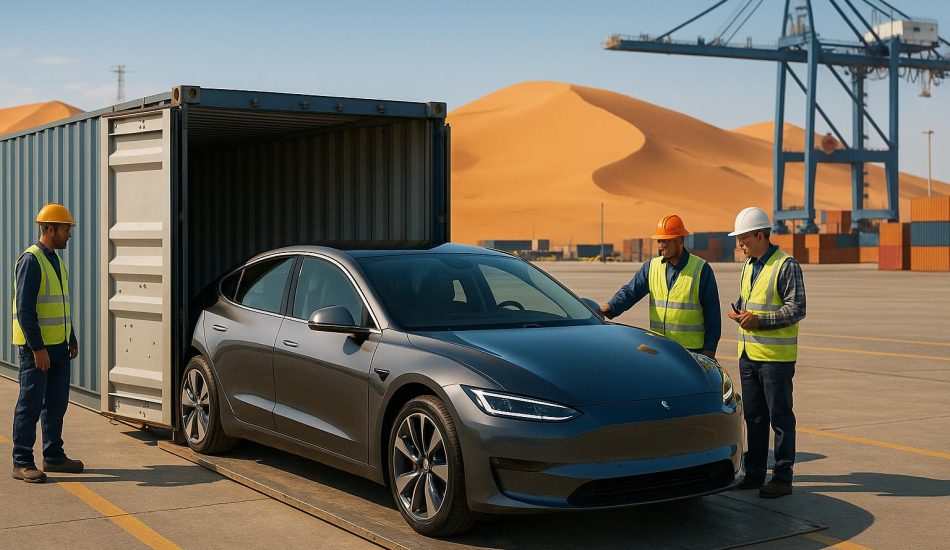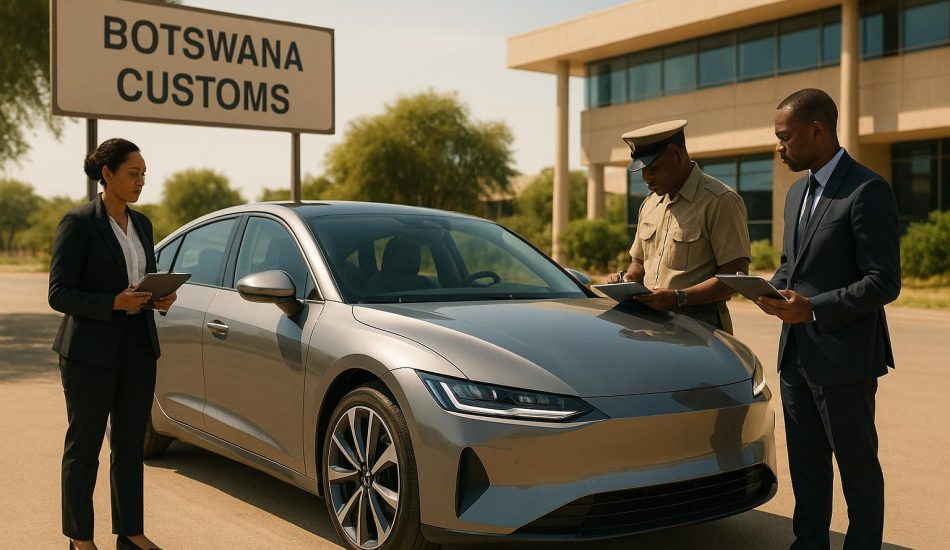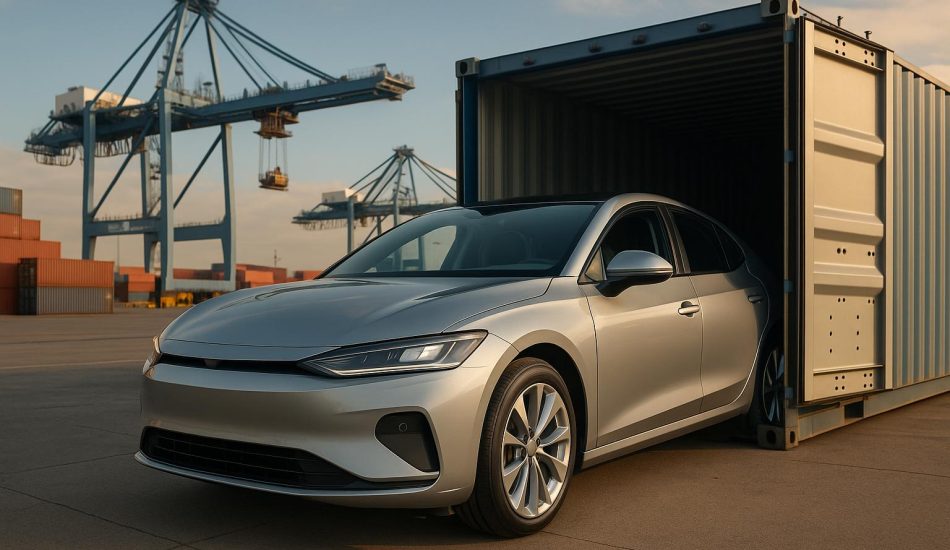
Zimbabwe’s 2025 EV import policy introduces reduced customs duties and tax incentives to encourage electric vehicle (EV) adoption. Starting January 1, 2025, the import duty on fully electric vehicles drops from 40% to 25%, significantly lowering costs for buyers. EVs also benefit from exemptions like no surtax for older vehicles and rebates for importing solar-powered charging equipment. However, hybrids remain subject to the full 40% duty.
Key highlights:
- Lower Costs: A $50,000 EV now incurs $12,500 in duty (down from $20,000).
- Charging Infrastructure: Duty rebates for solar EV charging equipment are available to approved operators.
- Exemptions: Electric tractors are entirely duty-free.
- Required Documents: Purchase invoice, bill of lading, ZIMRA forms, certificate of origin, and roadworthiness certificate.
Challenges include limited public charging stations and unreliable energy supply, though solar solutions and local lithium reserves offer growth potential. The government aims for 33% EV market penetration by 2030, with plans to expand renewable energy and infrastructure. Early adopters stand to save money and gain a head start in this growing market.
Complete guide to Importing a car to Zimbabwe
Import Costs and Financial Breakdown
Having a clear understanding of the financial aspects is crucial when making decisions about importing electric vehicles (EVs). With the 2025 policy changes, the cost of importing EVs is set to decrease, making them a more appealing option. Let’s break down the key cost components that now work in favor of EV importers.
EV Import Cost Components
Bringing an EV into Zimbabwe involves several cost elements, with the most notable change being the reduction in customs duty. Starting January 1, 2025, the customs duty rate for EVs will drop from 40% to 25%.
This reduced rate is applied to the vehicle’s CIF (cost, insurance, and freight) value, resulting in significant savings. For instance, importing a mid-range EV priced at US$50,000 would now incur a customs duty of US$12,500 instead of the previous US$20,000 – a savings of US$7,500.
Value Added Tax (VAT) remains unchanged at 15% and is calculated based on the total value, which includes freight, insurance, and other associated charges.
Other costs, such as shipping, port handling, registration, and inspection fees, vary depending on the vehicle’s origin and local requirements.
Additionally, electric tractors are completely exempt from customs duties, making them an attractive option for agricultural use.
EV vs. ICE Vehicle Cost Comparison
The financial benefits of importing EVs become even clearer when compared to internal combustion engine (ICE) vehicles. The updated policy creates a significant cost gap that favors EVs.
| Cost Component | EV | ICE Vehicle |
|---|---|---|
| Customs Duty | 25% | 40% |
| VAT | 15% | 15% |
| Surtax (vehicles > 5 years old) | 0% | 25% (if applicable) |
To illustrate, importing a US$50,000 EV would result in a customs duty of US$12,500, while an ICE vehicle of the same value would incur US$20,000 in customs duty – a difference of US$7,500. When VAT is applied to the total landed cost, the savings for EVs increase even further.
The cost advantage is even more striking for older vehicles. ICE vehicles over five years old are subject to an additional 25% surtax, which EVs are exempt from. For example, importing a six-year-old ICE vehicle valued at US$30,000 would result in a customs duty of US$12,000 and a surtax of US$7,500, totaling US$19,500 in duties and taxes before VAT is added.
These policy adjustments aim to strengthen Zimbabwe’s EV import market.
A practical example is the pricing of the BYD Atto 3. While the vehicle costs US$42,000 in South Africa and US$31,000 in Hong Kong, its price in Zimbabwe rises to US$71,000 due to import duties, shipping fees, and other local factors.
For businesses looking to electrify their fleets, the cost savings can be substantial. A company importing 10 mid-range EVs priced at US$50,000 each could save around US$75,000 in customs duties compared to importing ICE vehicles. These financial incentives align with Zimbabwe’s broader goals of promoting sustainable transportation.
Required Documents and Import Process Steps
Bringing an EV into Zimbabwe involves careful planning and preparation, especially when it comes to documentation. The process requires coordination with various government agencies and ensuring all necessary paperwork is in order to facilitate customs clearance and vehicle registration.
Required Documents for EV Import
To successfully import an EV into Zimbabwe, you’ll need to have all the required documents ready before the vehicle arrives at the port. Here’s what you’ll need:
- A purchase invoice that clearly states the vehicle’s value and specifications. Make sure it specifies that the vehicle is electric to qualify for the 25% duty rate.
- A bill of lading, issued by the shipping company, which serves as proof of shipment and ownership transfer. This document includes critical details like the vehicle’s origin, destination, and shipping terms. It’s vital that all documents consistently reflect the same vehicle details.
- Completed ZIMRA (Zimbabwe Revenue Authority) forms, which are the cornerstone of the customs clearance process. These forms, including the customs declaration, must accurately detail the vehicle’s specifications, value, and electric powertrain features. Any errors or inconsistencies could lead to delays or a reclassification of duty rates.
- A certificate of origin, which confirms where the vehicle was manufactured. This document is essential for customs officials to verify eligibility for the reduced duty rate and to ensure compliance with trade agreements.
- A roadworthiness certificate from the country of origin, proving that the vehicle meets basic safety standards. While local inspections may still be required upon arrival, having this certificate can help speed up the clearance process.
For businesses importing charging station equipment, additional steps are necessary. You’ll need licensing from the Zimbabwe Energy Regulatory Authority (ZERA) to qualify for rebates on equipment. ZERA maintains a list of approved operators eligible to import charging infrastructure, so it’s important to verify your inclusion on this list before proceeding.
Import Process Steps
Once your documents are ready, follow these steps to import an EV into Zimbabwe:
- Vehicle Purchase and Shipping Arrangements
After purchasing the EV, work with experienced freight forwarders who understand Zimbabwe’s import requirements. This is especially important for businesses new to international trade. - Pre-Arrival Documentation Preparation
While the vehicle is in transit, complete all required ZIMRA forms. Ensure the forms accurately reflect the EV’s specifications. This is a good time to double-check for any errors, as they can be corrected before the vehicle reaches Zimbabwe. - Arrival and Customs Inspection
Once the vehicle arrives, ZIMRA will review the submitted documents and conduct a physical inspection to verify the EV’s specifications. The 25% customs duty rate is applied only after confirming the vehicle’s electric powertrain. - Payment Processing
Pay all applicable duties, taxes, and fees. The reduced duty rate for EVs offers notable savings compared to traditional vehicles, so ensure calculations are accurate to avoid delays. - Vehicle Registration
The final step is registering the vehicle with local authorities. This includes obtaining Zimbabwean license plates, registering with the Central Vehicle Registry, and ensuring the EV complies with local regulations.
Navigating the complexities of customs regulations, tariffs, and documentation can be daunting for first-time importers. Ensuring every detail is handled correctly can save time and money. Close coordination with shipping companies, customs brokers, and government agencies is key to a smooth import process.
EV Import Timelines
Getting the timing right is key when importing an EV into Zimbabwe, especially considering the financial perks and the country’s infrastructure and regulatory challenges. The process involves several steps, each with potential delays, so understanding the timeline is essential for smooth planning.
Import Process Stages
- Shipping Phase
The time it takes to ship your EV depends on where it’s coming from and the shipping route you choose. Longer distances, bad weather, or congested ports can all add extra days – or even weeks – to this stage. - Document Preparation
Once you’ve purchased the vehicle, you’ll need to complete Form 47 (ZIMRA Customs Declaration Form) and gather key documents like the invoice, police clearance, export papers, and insurance statements. For first-time importers, this step can take longer due to unfamiliarity with the process. - Customs Clearance
Customs clearance is handled by ZIMRA when the EV arrives. However, this step can be delayed if your paperwork isn’t in order or if the declared value of the vehicle needs to be reassessed. Starting January 1, 2025, the 25% customs duty for EVs is expected to simplify this process, though verifying EV specifications may still add time. - Vehicle Registration
After clearing customs, you’ll need to register the vehicle with local authorities to get Zimbabwean license plates and update the Central Vehicle Registry. The time required for this step can vary depending on local administrative efficiency.
External factors, like infrastructure limitations, can add to these delays. Power outages, for instance, can disrupt port operations or slow down government processing systems. Tanaka Kutama, a business consultant and EV specialist, highlights the broader challenges:
"We have seen an increase in inquiries and imports, but infrastructure, and energy reliability remain major hurdles".
On top of that, the lack of clear policies and regulations surrounding EV imports can create uncertainty, particularly during customs clearance.
The timeline for importing an EV can vary widely depending on factors like the shipping origin, accuracy of your paperwork, customs procedures, and local administrative processes. Some importers may qualify for a $200 traveler’s rebate, which can help offset costs. To avoid unnecessary delays, work with experienced freight forwarders, stay in close contact with customs brokers, and keep backup documentation handy. Staying informed about policy updates is also critical for navigating this process efficiently.
sbb-itb-99e19e3
Challenges, Opportunities, and Future Outlook
Zimbabwe’s push toward electric vehicles (EVs) is a bold move that shines a spotlight on both hurdles and opportunities as the country navigates its transition to electric mobility.
Infrastructure and Energy Supply Issues
While the financial advantages of EVs are enticing, Zimbabwe faces significant challenges in infrastructure and energy supply. One major hurdle is the limited availability of public EV charging stations. This restricts EV usage primarily to urban areas, leaving long-distance travel largely impractical for most drivers.
On the energy front, the country’s electricity generation struggles to meet demand. Although Zimbabwe’s installed capacity is around 3,000 MW, the actual operational output is much lower due to aging infrastructure and frequent equipment failures. The situation at the Kariba Dam is a glaring example – its capacity has plummeted from 1,050 MW to just 125 MW because of reduced rainfall. Frequent power outages, some lasting up to 18 hours, further complicate the feasibility of widespread EV adoption.
Adding to these challenges is the financial strain of electricity imports. In 2023, Zimbabwe spent US$180 million on imported electricity, with projections suggesting this could rise to US$220 million in 2024. This reliance on external power sources raises questions about how sustainable it is to support a growing EV fleet under these circumstances.
Benefits for Early Adopters
Despite these challenges, early adopters of EVs stand to gain from several supportive policies. For starters, the reduction in EV import duty, effective January 1, 2025, offers immediate cost savings. Additionally, duty rebates for importing solar-powered EV charging station equipment create an opportunity for entrepreneurs to invest in much-needed infrastructure.
Zimbabwe’s abundant lithium reserves provide another advantage. By forming partnerships with international manufacturers, the country can position itself as a key player in the global EV market.
To address grid reliability issues, businesses are increasingly turning to solar solutions. A 25 MWp solar PV plant, for example, can be built for roughly US$20 million, making it a practical option for smaller-scale energy projects. This trend not only alleviates pressure on the national grid but also aligns with the broader push for renewable energy.
Zimbabwe’s EV Adoption Plans
The government has set an ambitious goal: achieving 33% EV market penetration by 2030. This aligns with broader regional trends, where experts predict that 4% to 8% of vehicles in Sub-Saharan Africa will be electric by 2030, with this figure rising to 25–35% by 2040 . However, addressing the country’s infrastructure and energy challenges is critical to meeting these targets.
To support this vision, Zimbabwe is working on a comprehensive EV policy framework, expected to roll out by the end of the year. Renewable energy is also a cornerstone of this strategy, with plans to increase renewables’ share in the energy mix to 27% by 2030. With solar energy potential ranging between 16–20 MJ/m²/day, the country is well-positioned to harness clean energy for EV adoption.
Local investment is already playing a role in renewable energy development. For instance, the National Social Security Authority (NSSA) and Old Mutual‘s investment arms have helped finance Centragrid‘s recently completed 25 MWp solar PV plant near Harare. This demonstrates how domestic capital can drive infrastructure projects.
Washington Zhakata, the Director of Climate Change Management at the Ministry of Environment, Climate and Wildlife, underscored the inevitability of this shift:
"Countries that are producing oil have been obliged under multilateral environmental agreements to reduce oil production and switch to renewable energy. So, the issue of electric vehicles is inevitable. We can’t run away from it".
The government acknowledges that public-private partnerships will be essential to bridging infrastructure gaps and speeding up EV adoption. Zimbabwe’s success will depend on overcoming these obstacles while leveraging its natural resources and forward-thinking policies.
Conclusion
Zimbabwe’s 2025 EV import policy marks a turning point for the country’s transition to electric mobility. By reducing import duties from 40% to 25%, the government has made electric vehicles (EVs) more affordable than ever. For budget-friendly models priced around $20,000, this duty adjustment translates into meaningful savings, making EV ownership a more realistic option for many importers. These cost savings also pave the way for increased investment in charging infrastructure and a broader adoption of EVs.
Additionally, the policy’s appeal is further strengthened by rebates on solar-powered charging equipment, offering a financial incentive for early adopters to not only import EVs but also contribute to the development of a sustainable charging ecosystem. This dual opportunity underscores the government’s commitment to fostering a greener, more energy-efficient future.
The long-term vision is clear: Zimbabwe aims to cut emissions by 40% across all sectors by 2030. This ambitious target provides reassurance of continued government support for EV adoption, creating a stable environment for forward-thinking importers. As Kudakwashe Ngoni, an EV owner from Harare, puts it:
"We are hopeful to see more electric vehicles on the roads. I currently drive one, and it has been a great investment".
While challenges like limited charging infrastructure and energy reliability persist, the combination of reduced costs, government incentives, and a clear regulatory framework makes the case for early adoption compelling. For those ready to act, the benefits extend beyond financial savings – they also position themselves as pioneers in Zimbabwe’s shift toward electric mobility.
FAQs
What tax incentives are offered for importing electric vehicles into Zimbabwe under the 2025 policy?
Zimbabwe’s 2025 EV Import Policy: Lower Duties, Bigger Savings
Zimbabwe’s 2025 electric vehicle (EV) import policy brings good news for anyone looking to switch to greener transportation. Import duty rates have been significantly reduced, making EVs more accessible. The standard import duty has dropped from 40% to 25%, cutting costs for buyers. On top of that, customs duties on EVs have been slashed by an additional 15%.
These measures aim to ease the financial strain for individuals and businesses importing EVs, all while promoting a shift toward electric mobility and cleaner transportation options in the country.
What are the key differences in the import process for electric vehicles (EVs) compared to traditional gas-powered vehicles in Zimbabwe?
Importing Electric Vehicles (EVs) into Zimbabwe
Bringing electric vehicles (EVs) into Zimbabwe comes with its own set of steps and requirements, which differ from those for gas-powered internal combustion engine (ICE) vehicles. For EVs, you’ll need specialized documentation to confirm that the car meets specific emission and safety standards tailored to electric mobility. Depending on the situation, you might also need permits or certifications from regulatory bodies that oversee EV imports.
In contrast, importing ICE vehicles tends to follow more familiar and established procedures. This usually includes standard paperwork like proof of ownership, customs declarations, and general safety compliance. While the process for ICE vehicles is more streamlined, EV imports often involve additional steps, such as verifying EV-specific standards and registering under newer regulatory frameworks. These extra requirements align with Zimbabwe’s 2025 EV policy, aimed at supporting the country’s transition to electric mobility.
What are the main challenges Zimbabwe faces in developing EV infrastructure, and what steps are being taken to address them?
Zimbabwe faces a range of obstacles in building the infrastructure needed to support widespread electric vehicle (EV) adoption. Among the key issues are an underdeveloped electricity network, a lack of public charging stations, and frequent power grid reliability problems.
To tackle these hurdles, the government has rolled out initiatives like the National Policy Roadmap for Electric Mobility, which lays out strategies to enhance EV infrastructure. At the same time, private companies are stepping up to help, focusing on expanding charging networks and improving electricity access. While there’s progress, achieving a smooth shift to electric mobility will require ongoing investment and strong collaboration between public and private sectors.




